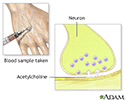Cholinesterase - blood
Acetylcholinesterase; RBC (or erythrocyte) cholinesterase; Pseudocholinesterase; Plasma cholinesterase; Butyrylcholinesterase; Serum cholinesterase
Serum cholinesterase is a blood test that looks at levels of 2 substances that help the nervous system work properly. They are called acetylcholinesterase and pseudocholinesterase. Your nerves need these substances to send signals.
Acetylcholinesterase is found in nerve tissue and red blood cells. Pseudocholinesterase is found primarily in the liver.
How the Test is Performed
A blood sample is needed. Most of the time blood is drawn from a vein located on the inside of the elbow or the back of the hand.
How to Prepare for the Test
No special steps are needed to prepare for this test.
How the Test will Feel
You may feel slight pain or a sting when the needle is inserted. You may also feel some throbbing at the site after the blood is drawn.
Why the Test is Performed
Your health care provider may order this test if you may have been exposed to chemicals called organophosphates. These chemicals are used in pesticides. This test can help determine your risk of poisoning.
Less often, this test may be done:
- To diagnose liver disease
- Before you receive anesthesia with succinylcholine, which may be given before certain procedures or treatments, including electroconvulsive therapy (ECT)
Normal Results
Typically, normal pseudocholinesterase values range between 8 and 18 units per milliliter (U/mL) or 8 and 18 kilounits per liter (kU/L).
Note: Normal value ranges may vary slightly among different laboratories. Talk to your provider about the meaning of your specific test results. Levels can vary from person to person, so having a baseline level makes the test more accurate.
What Abnormal Results Mean
Decreased pseudocholinesterase levels may be due to:
- Hereditary deficiency of pseudocholinesterase
- Chronic infection
- Chronic malnutrition
- Heart attack
- Liver damage
- Metastasis
- Obstructive jaundice
- Poisoning from organophosphates (chemicals found in some pesticides)
- Inflammation that accompanies some diseases
Smaller decreases may be due to:
- Pregnancy
- Use of birth control pills
References
Hall JE, Hall ME. The autonomic nervous system and the adrenal medulla. In: Hall JE, Hall ME, eds. Guyton and Hall Textbook of Medical Physiology. 14th ed. Philadelphia, PA: Elsevier; 2021:chap 61.
Nelson LS. Acute poisoning. In: Goldman L, Schafer AI, eds. Goldman-Cecil Medicine. 26th ed. Philadelphia, PA: Elsevier; 2020:chap 102.
Ritter JM, Flower R, Henderson G, Loke YK, MacEwan D, Rang HP. Chemical mediators and the autonomic nervous system. In: Ritter JM, Flower R, Henderson G, Loke YK, MacEwan D, Rang HP, eds. Rang and Dale's Pharmacology. 9th ed. Philadelphia, PA: Elsevier; 2020:chap 13.
Review Date: 4/29/2023
Reviewed By: Joseph V. Campellone, MD, Department of Neurology, Cooper Medical School of Rowan University, Camden, NJ. Review provided by VeriMed Healthcare Network. Also reviewed by David C. Dugdale, MD, Medical Director, Brenda Conaway, Editorial Director, and the A.D.A.M. Editorial team.







